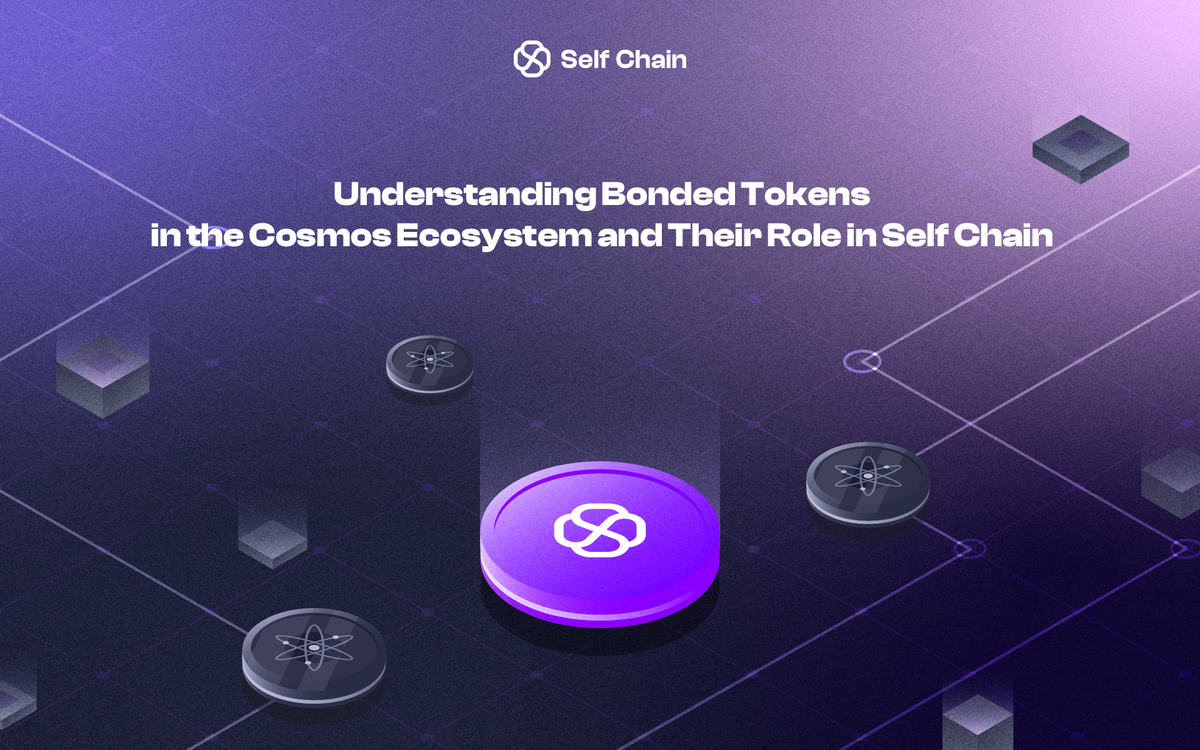Understanding Bonded Tokens in the Cosmos Ecosystem and Their Role in Self Chain
In the Cosmos ecosystem, bonded tokens are essential for securing the network and ensuring its proper operation.

What are Bonded Tokens?
In the Cosmos ecosystem, bonded tokens are essential for securing the network and ensuring its proper operation. Bonding tokens, usually through staking, involves locking a portion of a blockchain's native tokens to participate in network activities such as validating transactions and safeguarding the network.
Bonded tokens are a key component of the Delegated Proof of Stake (DPoS) mechanism employed by Cosmos and its interconnected blockchains. When tokens are bonded, they are no longer part of the circulating supply but are instead committed to supporting the network’s operations. This commitment helps prevent potential security risks like 51% attacks, where a single entity could control a majority of the network’s staking power.
How Bonded Tokens Work in Cosmos
In the Cosmos ecosystem, bonded tokens primarily serve to:
- Secure the Network: Validators, who run nodes and verify transactions, must bond a significant amount of tokens. This stake acts as collateral, ensuring that validators act in the network's best interest. If a validator behaves maliciously, their bonded tokens can be slashed as a penalty.
- Earn Rewards: Validators and delegators (those who delegate their tokens to validators) earn rewards from block production and transaction fees. These rewards are distributed proportionally to the amount of tokens bonded.
- Governance: Bonded tokens often provide holders with voting power in governance proposals. This allows the community to participate in decision-making processes related to network upgrades, parameter changes, and more.
Self Chain and Its Role in the Cosmos Ecosystem
Self Chain, being part of the Cosmos ecosystem, also follows a similar mechanism for bonded tokens. As a Delegated Proof of Stake (DPoS) blockchain, Self Chain utilizes bonded tokens to protect the system from a 51% attack, which occurs when a single entity or a colluding group controls more than 50% of the voting power or delegated stake in the network. By bonding vested tokens, the network is secured, making it more resilient against attacks and ensuring its proper functioning.
The system operates similarly to other DPoS blockchains like Sui, Aptos, and Celesia:
| Project | Bonded Tokens | Circulating Supply | Explorer |
|---|---|---|---|
| Sui | 7,961,000,000 SUI | 2,679,000,000 SUI | suiscan |
| Aptos | 873,000,000 APT | 485,000,000 APT | aptoscan |
| Celesia | 784,500,000 TIA | 208,000,000 TIA | celenium |
| Kava | 138,000,000 KAVA | 1,082,000,000 KAVA | mintscan-kava |
| Osmos | 357,000,000 OSMO | 680,000,000 OSMO | mintscan-osmos |
| Self Chain | 221,000,000 SLF | 97,000,000 SLF | selfchainexplorer |
Current Self Chain Bonded Tokens and Circulating Supply
Self Chain’s bonded tokens and circulating supply reflect the commitment of its community to maintaining network security and decentralization. The current circulating supply is 97,000,000 SLF, with a significant amount of SLF bonded to secure the network.
As the $FRONT to $SLF migration progresses, the circulating supply of $SLF will increase as more tokens are issued to validators and users transition their holdings. This dynamic is common in DPoS systems and is crucial for balancing network security with liquidity.
Conclusion
Bonded tokens are distinct from the circulating supply in the Cosmos ecosystem, including the Self Chain. In the early stages of a network, a higher amount of bonded tokens enhances security, as seen in networks like Sui, Aptos, and Celesia. As the network matures and stabilizes, the number of bonded tokens typically decreases in relation to the circulating supply, similar to what we observe with Kava and Osmosis.
By understanding the role of bonded tokens in securing the network and facilitating governance, stakeholders can better appreciate the security measures in place and the opportunities for earning rewards through staking. For more details and real-time data on bonded tokens and circulating supply, visit the Self Chain Explorer.
About Self Chain
Self Chain is the first Modular Intent-Centric Access Layer1 blockchain and keyless wallet infrastructure service using MPC-TSS/AA for multi-chain Web3 access. The innovative system simplifies the user experience with its intent-focused approach, using LLM to interpret user intent and discover the most efficient paths.
Self Chain ensures that onboarding and recovery are effortless with keyless wallets that grant users complete self-custody over their assets. In addition, it provides automated rewards to dApps when they efficiently resolve user intent, further enhancing the user experience. Moreover, Self Chain incorporates Account Abstraction with MPC-TSS to provide secure signing and reduce transaction fees. It's a platform that redefines blockchain interaction, making it more secure and user-friendly for everyone.
In a world where blockchain technology is becoming increasingly essential, the user experience remains a critical factor in its adoption. Intents and Keyless Wallets are set to transform the landscape, making blockchain interactions more accessible, efficient, and secure. As we move forward, the blockchain industry has the opportunity to provide users with a seamless and enjoyable experience, unlocking the full potential of this groundbreaking technology.
